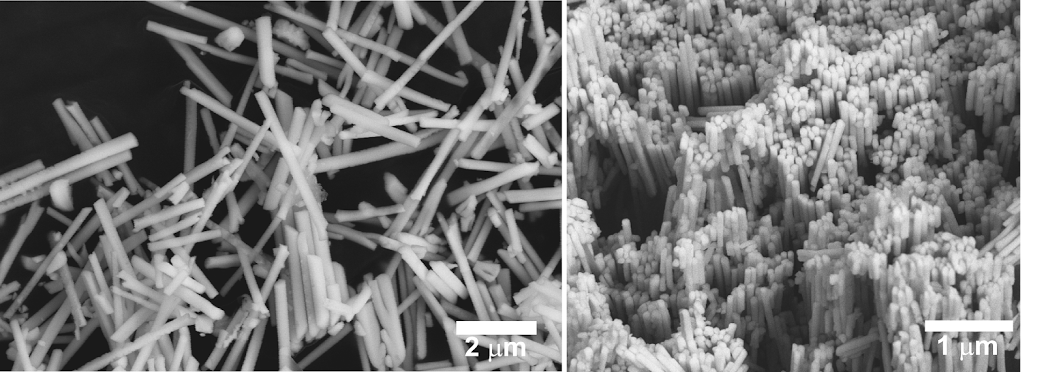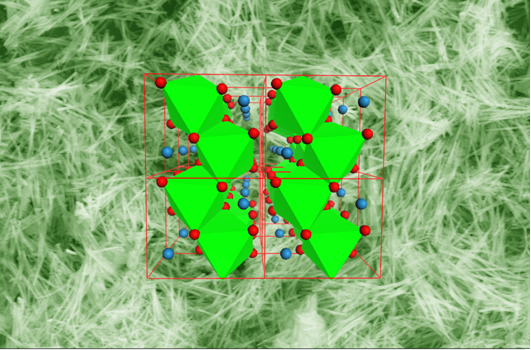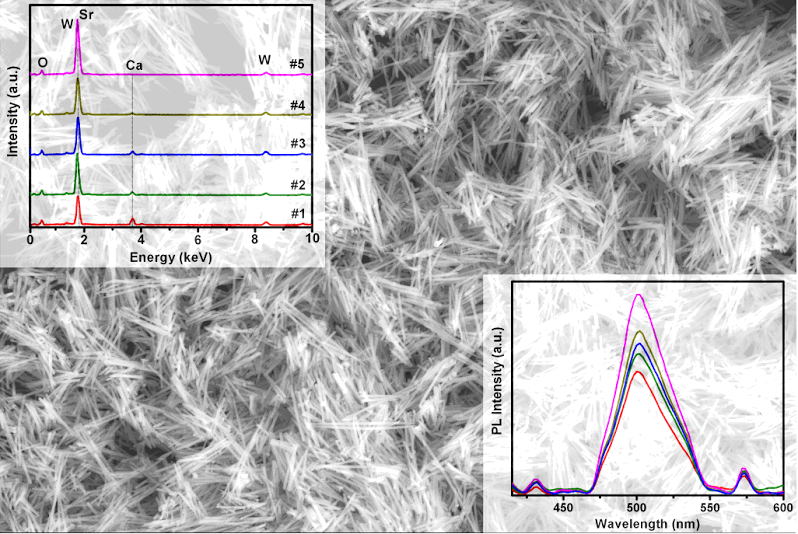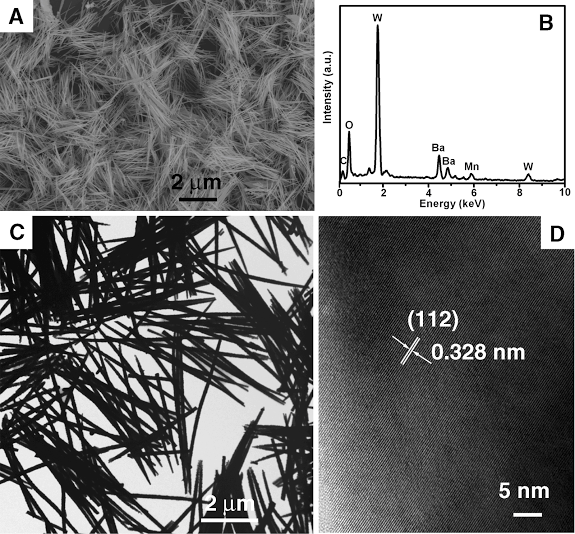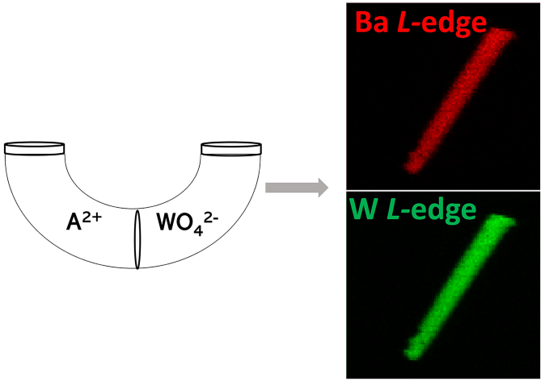Tungstates
1. Single-crystalline BaWO4 and BaCrO4 nanorods (100 and 200 nm diameter-sized examples) were controllably prepared using a simple, room temperature approach, based on the use of porous alumina template membranes. Aligned BaWO4 and BaCrO4 nanorod arrays could be obtained by dissolving the template. Ref.: J. Am. Chem. Soc., v.126, 15245 (2004).
2. Polycrystalline, multiferroic MnWO4 nanowires and nanowire arrays with controllable chemical composition and morphology, using a modified template-directed methodology under ambient room-temperature conditions. We were able to synthesize nanowires measuring 55 ± 10 nm, 100 ± 20 nm, and 260 ± 40 nm in diameter, respectively, with lengths ranging in the microns. Ref.: J. Solid State Chem., v.181, 1539 (2008) [invited].
3. Single-crystalline alkaline-earth metal tungstates AWO4 (A = Ca, Sr, Ba) nanorods, as well as the corresponding series of their crystalline solid-solution analogues, Sr1-xCaxWO4 and Ba1-xSrxWO4 (0 < x < 1), with varying controllable sizes. As-obtained photoluminescent lifetimes and quantum yields suggest that these nanoscale materials are comparable in optical behavior to those of bulk. The composition-modulated luminescence properties over several distinctive series of as-prepared solid-solution nanorods of alkaline-earth metal tungstates provide the fundamental basis for a more thorough investigation and understanding of their optical and optoelectronic properties, which may eventually lead to the rational incorporation of these materials into functional nanoscale devices. Ref.: Chem. Mater., v.20, 5500 (2008).
4. Uniform Mn-doped alkaline-earth metal tungstate, AWO4 (A = Ca, Sr, Ba), nanorods of reproducible size, shape, and composition have been methodically prepared using a modified template-directed methodology under ambient, room-temperature conditions. The dopant ion distribution within the nanostructures does not appear to adversely affect either the structural or crystalline integrity of our as-prepared compounds, as determined by microscopy and diffraction studies. What is much more important is the fact that the presence of Mn+2 not only substantially increases the photoluminescent potential of a pristine tungstate material but also reinforces its versatility by adding a desirable magnetic component to its repertoire of properties. In so doing, we have created multifunctional one-dimensional nanorods with exciting opto-magnetic behavior, which should become important for the future incorporation of these materials into functional nanoscale devices, with various potential applications in a number of diverse fields. Ref.: J. Phys. Chem. C, v.112, 14816 (2008).
5. Synchrotron-based scanning hard X-ray microscopy (SHXM) was used to extract localized chemical and structural information within a system of model alkaline-earth-metal tungstate nanorods, characterized by multiple chemical configurations. Specifically, we have highlighted the practical ability of SHXM to probe chemically distinctive nanoscale species, i.e. (i) chemically-doped versus (ii) solid-solution-state nanorods of comparable dimension, synthesized using a template-directed method under ambient conditions. Indeed, we show that SHXM can be used to map out elemental distributions within individual anisotropic nanorods with nanoscale resolution, coupled with chemical sensitivity and specificity. Complementary electrochemical results suggest the possibility of using these nanorods as support materials for electro-oxidation reactions within an acidic electrolyte medium. Our structural and chemical composition results have been corroborated using parallel lines of inquiry involving scanning electron microscopy, transmission electron microscopy, energy dispersive X-ray spectroscopy, X-ray diffraction, and X-ray photoelectron spectroscopy. These measurements confirmed the relatively even and uniform distribution of the expected, individual elements within all of the nanorod samples tested. Ref..: J. Phys. Chem. C, v.123, 17185 (2019).
6. We have synthesized several morphologies and crystal structures of MgWO4 using a one- pot hydrothermal method, producing not only monoclinic stars and large nanoparticles but also triclinic wool balls and sub 10 nm nanoparticles. Herein we describe the importance of reaction parameters in demonstrating morphology control of as-prepared MgWO4. Moreover, we correlate structure and composition with the resulting photoluminescence and radioluminescence properties. Specifically, triclinic-phase samples yielded a photoluminescence emission of 421 nm, whereas monoclinic-phase materials gave rise to an emission maximum of 515 nm. The corresponding radioluminescence data were characterized by a broad emission peak, located at 500 nm for all samples. Annealing the wool balls and sub-10 nm particles to transform the crystal structure from a triclinic to a monoclinic phase yielded a RL emission signal that was two orders of magnitude greater than that of their unannealed counterparts. Finally, to confirm the practical utility of these materials for biomedical applications, a series of sub-10 nm particles, including as-prepared and annealed samples, were functionalized with biocompatible PEG molecules, and subsequently were found to be readily uptaken by various cell lines as well as primary cultured hippocampal neurons with low levels of toxicity, thereby highlighting for the first time the potential of this particular class of metal oxides as viable and readily generated platforms for a range of biomedical applications. Ref.: invited contribution, Royal Society Open Science, 9(12), 220994 / 1-20 (2022). 7. Zinc tungstate is a semiconductor known for its favorable photocatalytic, photoluminescence, and scintillation properties, coupled with its relatively low cost, reduced toxicity, and high stability in biological and catalytic environments. In particular, zinc tungstate evinces scintillation properties, namely the ability to emit visible light upon absorption of energetic radiation such as X-rays, which has led to applications not only as radiation detectors but also for biomedical applications involving the delivery of optical light to deep tissue, such as photodynamic therapy and optogenetics. Herein, we report on the synthesis of zinc tungstate nanorods generated via an optimized but facile method, which allows for synthetic control over the aspect ratio of the as-synthesized anisotropic motifs via rational variation of the solution pH. We investigate the effect of aspect ratio upon their resulting photoluminescent and radioluminescent properties. We further demonstrate the potential of these zinc tungstate nanorods for biomedical applications, such as photodynamic therapy for cancer treatment, by analyzing their toxicological profile within cell lines and neurons. Ref.: invited contribution, special issue, JCP Festschrift in honor of Louis E. Brus, J. Chem. Phys., in press.
|

